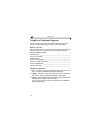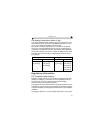
63
Chapter 10
rechargeable batteries delivered the best results in a variety of conditions.
Ni-MH batteries are designed for high-demand devices, such as digital
cameras, and do not exhibit the “memory” effects seen with other
rechargeable technologies.
m Battery performance is reduced at temperatures below 41° F (5° C).
Carry spare batteries when using your camera in cold weather, and keep
them warm until you are ready to take pictures. Do not discard cold
batteries that do not work. Once they are warmed, they may be usable.
Tips, Safety, Maintenance
m Always follow basic safety precautions. Refer to the “Important Safety
Instructions” booklet packed with your camera.
m Do not allow any chemicals, such as suntan lotion, to come into contact
with the painted surface of the camera.
m If the camera has been subjected to inclement weather or you suspect
water has gotten inside the camera, turn off the camera and remove the
battery and MMC/SD card. Allow all components to air-dry for at least 24
hours before using the camera again.
m Clean the lens and back LCD:
1 Blow gently on the lens or LCD to remove dust and dirt.
2 Moisten the lens or LCD by breathing lightly on it.
3 Wipe the lens or LCD gently with a soft, lint-free cloth or an untreated
lens-cleaning tissue.
Do not use cleaning solutions unless they are designed specifically for
camera lenses. Do not wipe the camera lens or LCD with chemically
treated eyeglass lens tissue. It may scratch the lens.


















